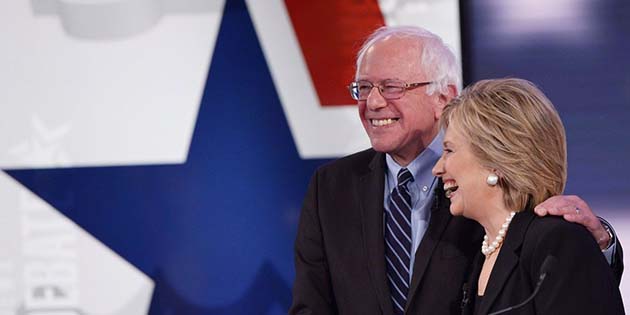Bernie Sanders’ loss in the Democratic primaries exposes the true nature of the party—and why efforts to change it from within are a dead end, argues Solidarity
Bernie Sanders spent the last year profoundly shaking the US political system. Promising a political revolution against the 1 per cent, he railed against the control of politics by the billionaire class, recalling the slogans of the Occupy movement against Wall Street, the bank bailouts and austerity. The self-described socialist generated a wave of enthusiasm Hillary Clinton could not match.
Sanders drew enormous crowds of 19,000 in Portland, 20,000 in Boston and 27,000 in Los Angeles to hear him speak. In the end, he won 23 of the 57 Democratic primaries and over 13 million votes. His campaign raised over $200 million, mostly from small individual donations—unlike Hillary Clinton’s current corporate-funded $500 million war chest.
The policies Sanders put forward offered an alternative to the usual lacklustre presidential race between Democrats and Republicans, the two enthusiastic parties of American capitalism, with a twin commitment to neo-liberalism.
Sanders exposed Clinton’s corporate backing, declaring during the Michigan primaries: “One of us has a super PAC. One of us has raised $15 million from Wall Street for that super PAC. One of us has given speeches on Wall Street for hundreds of thousands of dollars.”
But Sanders was clear from the start that he would back whoever became the Democratic candidate, which meant eventually falling in line behind Clinton.
Collapse into Clinton
Tragically, Sanders has now thrown away the desire for an alternative to corporate dominated politics as usual to channel support back into the dead end of the Democratic Party.
The election contest now looks quite bleak, between unhinged racist Donald Trump and Wall Street favourite Hillary Clinton.
Sanders finally declared his formal support for Hillary Clinton at the Democratic National Convention in July. “We need leadership in this country which will improve the lives of working families, the children, the elderly, the sick and the poor,” Sanders told delegates. “Based on her ideas and her leadership – Hillary Clinton must become the next president of the United States. The choice is not even close.”
Since his close defeat in the primaries Sanders has worked to pull the left vote and his former supporters into line behind Clinton. In early October he echoed Democratic fear-mongering that a vote for a third party candidate was essentially a vote for Trump.
Clinton remains the preferred ruling class candidate. She has endorsements from war criminals and corporate heads. She’s celebrated for reaching across the aisle for Republican votes—George Bush Senior has added his name to the Republican endorsee list!
Sanders’ endorsement is a bitter pill to swallow for many supporters after months campaigning for a “political revolution” and exposing the entrenched wealth that wields true power inside the Democratic Party—the very things that Clinton represents. Protests and walkouts by disaffected Sanders supporters rocked the Democratic convention.
Although the Democrats’ 2016 policy platform has been widely touted the most progressive in the party’s history, the Sanders revolution hasn’t pulled the Democratic party to the left on any issue.
Single payer healthcare remains off the agenda, as does free higher education. There is rhetorical support for a $15 minimum wage, but no national policy to enforce it.
The meaningless phrase “comprehensive immigration reform” appears, but the platform is deafeningly silent on deportations—more of which have been carried out by Obama than any other president in history. Fracking and the settlements in Palestine will continue under another Democratic presidency. Far from changing the Democrats from within, Sanders is now left using his anti-system popularity to hand the left vote to a candidate representing everything he campaigned against.
The Democrats
It was a mistake to think that Sanders could ever win the Democratic nomination on a radical platform.
The Democratic Party machine heavily backed establishment candidate Hillary Clinton. As the Democratic Convention opened, leaked emails showed the bias against Sanders of supposedly neutral top party officials, along with evidence that they tried to discredit his campaign. The odds were stacked against him despite his huge grassroots popularity.
The Democratic Party is a capitalist party funded by big business and controlled by the elite. Unlike the Labor Party in Australia it has never had a formal membership or the same connection to the trade unions. The Labor Party leadership here sells out its working class base again and again, but unions still hold half the votes at party conferences and it at least has a branch and conference structure where members can influence policy. The Democrats have no such connections to ordinary people.
In New Hampshire Sanders won the primary by a landslide. Clinton lost by more than 20 per cent, but she won as many delegates as Sanders.
The party has a system of “superdelegates”—party bureaucrats who hold around a sixth of delegate votes in the Democratic National Convention—who can support whichever candidate they like, regardless of registered members’ opinions or votes. It’s a safeguard against anyone too unpredictable winning through.
If they can’t use corporate funding or party rules to get around ordinary delegates and members, the Democrats can always use other means to oust progressive candidates.
It has a long history of undermining left-wing challenges. In the 1930s, socialist Upton Sinclair actually won the Democratic nomination for state governor. His election plans included worker-run co-operative farms, a progressive tax on the rich at 30 per cent and guaranteed pensions.
Roosevelt and the Democratic Party machine funneled money to the Republicans and even ran a third party candidate to take votes away from Sinclair. This handed the election to Republican Frank Merriam, showing how far the Democrats were willing to go to stop radical candidates.
Even during the height of the anti-Vietnam war movement, despite the demand for an anti-war candidate at the 1968 convention party bureaucrats installed Lyndon Johnson’s pro-war Vice President Hubert Humphrey as the presidential nominee.
Our “Revolution”
There is a desperate need for a third party that could genuinely represent working class people in the US. But instead, since losing the nomination, Sanders has continued trying to change the Democratic Party from within, reinforcing the logic of a two party system and drawing people into the Democratic electoral machine.
At the end of August he launched “Our Revolution,” an organisation dedicated to running progressive candidates inside the Democratic Party. This uninspiring non-profit has had trouble capturing the fast-dissipating Sanders momentum. More than half its staff resigned the night before its launch. More than 3000 supporters and 122 Sanders delegates signed a petition criticising the structure and politics of the organisation.
Our Revolution has no democratic selection process or set of standards that determine who or what makes a “progressive” candidate.
It targets local candidates who have the least power to set national debates and agenda on the policies that enlivened the Sanders campaign in the first place. This dead-end strategy of fighting inside the Democratic Party was what ensured the Sanders revolution’s defeat.
Third party
Sanders’ collapse into the Clinton campaign should come as no surprise. From the outset Sanders committed to fighting within the Democratic Party and built no independent left organisation or coalitions.
Around two thirds of former Sanders supporters will grit their teeth vote for Clinton in November. But the opportunities to break open the two-party system exist.
Jill Stein, presidential nominee for the Green Party reached out to Sanders in July calling on him to run a joint ticket, but to no avail.
Clinton is a tremendously unpopular “lesser evil”, her support base glued together mainly by the horror people feel toward Trump. A break with the Democrats by Sanders to align with the Green Party and other left forces could have changed the conversation.
There has been trickle of support toward Stein. A CNN poll following the Democratic National Convention found that 13 per cent of Sanders supporters and sympathetic independents now plan to vote for her, nearly double the number prior to the convention.
Anu Pulskamp was a state delegate for Sanders during the primaries who now supports Stein. Interviewed in The Guardian last month Pulskamp said, “voting for Jill at this point is continuing his revolution. I think by me voting for the third-party candidate, along with millions of other Bernie supporters, it will maybe show that the third party is possible in the future… I don’t want a two-party system any more. I don’t think it’s fair.”
The task for the US left now is translating the Sanders revolution into a real political alternative to the Republicans and the Democrats.
None of the anti-capitalist sentiment that fuelled Sanders’ popularity has gone away. The “recovery” following the economic crisis is weak and restored profits haven’t trickled down to wages or social services. The abject hatred for business as usual that brought us Sanders on the one hand and Trump on the other remain an unresolved political crisis in the US and across the world.
This means voting for Jill Stein and the Green Party in November, but it also crucially means building the political strength for change in social movements outside the White House.
The millions who were inspired by Sanders are the possible base for powerful movements for change. They can reinvigorate the fight for a $15 an hour minimum wage, led by fast food workers, which has already forced two states, California and New York, to raise the minimum wage.
They can help deepen the Black Lives Matter movement, which has already turned police killings into a national issue.
The Sanders phenomenon has shown the potential for building a grassroots movement for socialism in the US. But it is up to the left outside the Democrats to make that a reality.






